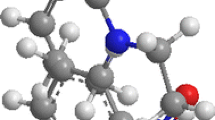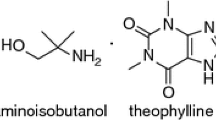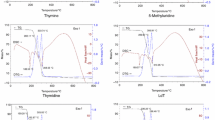Abstract
Purpose. The degradation kinetics of thymopentin (RKDVY) and its analogs (RKDVW and RPDVY) in aqueous solution was studied by isothermal and nonisothermal methods.
Methods. The isothermal decomposition of thymopentin and its analogs was investigated as a function of pH (2−10), temperature (37, 57, and 80°C) and ionic strength (μ = 0.02 to 1). Nonisothermal decomposition studies were performed using a linear temperature programmer. The temperature increasing rate was set to 0.25°C per hour and the temperature interval varied from 40 to 88°C.
Results. The decomposition of thymopentin and its analogs followed first order kinetics. The dependence of the rate constant on temperature followed a linear Arrhenius plot. This indicated that the degradation mechanism of thymopentin and its analogs might be the same within the temperature range studied. The energies of activation were found to be in close agreement for the isothermal and nonisothermal studies, suggesting that the nonisothermal studies may save considerable amount of time in the early stages of drug development. The logK-pH profile of thymopentin suggests that maximum stability is achieved in the pH range of 6−8.
Conclusions. These results indicate that the nonisothermal methodology provides an attractive alternative to isothermal methods, as it requires a much lower amount of both material and time, to determine the peptide stability and to estimate the shelf-life for peptide pharmaceutical preparations.
Similar content being viewed by others
REFERENCES
E. Audibert. The transitory fusion of coal. Rev. Indust. Min. 6:253–259 (1926).
J. P. Baur, D. W. Bridges, and W. M. Fassel. High pressure oxidation of metals under linear temperature increase. J. Electrochem. Soc. 102:490–496 (1955).
P. Kofstad. Oxidation of metals: Determination of activation energies. Nature 179:1362–1363 (1957).
A. R. Rogers. An accelerated storage test with programmed temperature rise. J. Pharm. Pharmacol. 15:101T–105T (1963).
K. Ellstrom. Non-isothermal stability testing of drug substances in the solid state. Acta Pharm. Suec. 24:115–122 (1987).
J. O. Waltersson and P. Lundgren. Nonisothermal kinetics applied to drugs in pharmaceutical suspensions. Acta. Pharm. Suec. 20:145–154 (1983).
J. E. Kipp. Nonisothermal kinetics-comparison of two methods of data treatment. Int. J. Pharm. 26:339–354 (1985).
J. E. Kipp, M. M. Jensen, K. Kronholm, and M. MsHalsky. Automated liquid chromatography for nonisothermal kinetic studies. Int. J. Pharm. 34:1–8 (1986).
J. E. Kipp and J. J. Hlavaty. Nonisothermal stability assessment of stable pharmaceuticals: testing of a clindamycin phosphate formulation. Pharm. Res. 8:570–575 (1991).
B. R. Cole and L. Leadbeater. A critical assessment of an accelerated storage test. J. Pharm. Pharmacol. 18:101–111 (1966).
B. R. Cole and L. Leadbeater. Estimation of the stability of dry horse serum cholinesterase by means of an accelerated storage test. J. Pharm. Pharmacol. 20:48–53 (1968).
B. W. Madsen, R. A. Anderson, D. Herbison-Evans, and Sneddon. Integral approach to nonisothermal estimation of activation energy. J. Pharm. Sci. 63:777–781 (1974).
G. Goldstein, M. P. Scheid, E. A. Boyse, D. H. Schlesinger, and Van J. Wauwe. A synthetic pentapeptide with biological activity characteristic of the thymic hormone thymopoietin. Science 204:1309–1310 (1979).
D. H. Schlesinger and G. Goldstein. The amino acid sequence of thymopoietin II. Cell 5:361–365 (1975).
T. Audhya, D. H. Schlesinger, and G. Goldstein. Complete amino acid sequences of bovine thymopoietins I, II and III: closely homologous polypeptides. Biochemistry 20:6195–6200 (1981).
G. A. Heavner, T. Audhya, D. Oyle, F. S. Tjoeng, and G. Goldstein. Biologically active conformations of thymopentin. Int. J. Peptide Protein Res. 37:198–209 (1991).
V. J. Helm and B. W. Muller. Stability of the synthetic pentapeptide thymopentin in aqueous solution: effect of pH and buffer on degradation. Int. J. Pharm. 70:29–34 (1991).
Author information
Authors and Affiliations
Rights and permissions
About this article
Cite this article
Lee, ML., Stavchansky, S. Isothermal and Nonisothermal Decomposition of Thymopentin and Its Analogs in Aqueous Solution. Pharm Res 15, 1702–1707 (1998). https://doi.org/10.1023/A:1011952511091
Issue Date:
DOI: https://doi.org/10.1023/A:1011952511091




